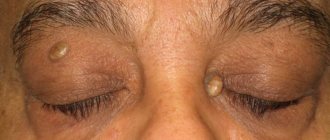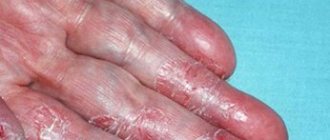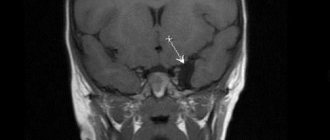The article was prepared by a specialist for informational purposes only. We urge you not to self-medicate. When the first symptoms appear, consult a doctor.
This benign formation is formed due to blockage of the excretory duct of the sebaceous gland. It can be single or multiple, when the entire surface of the scrotum is covered with a large number of atheromas, resembling a pustular rash. In the latter case, the man is diagnosed with atheromatosis.
Atheroma, or sebaceous gland cyst, develops in the hair follicle. For various reasons, the excretory duct becomes blocked, and the secretion cannot find its way out. Mixing with dead skin cells, it accumulates in the sebaceous gland, stretching it and forming a compaction, the color of which is slightly lighter than the color of the surrounding skin. In the center of the atheroma, you can find a black dot - a clogged mouth of the gland.
The consistency of the formation is soft, elastic, has an even rounded contour, reaches a size of 1-1.5 cm in diameter. A primary sebaceous cyst is painless until it becomes inflamed. In contrast, secondary atheroma has a denser consistency and is painful when pressed. Secondary cysts of the sebaceous glands of the scrotum appear in large numbers in men suffering from seborrhea and hyperhidrosis, and are diagnosed as seborrheic cysts, or Fordyce cysts.
Due to friction with underwear and mechanical damage to the skin, scrotal atheromas can spontaneously open. The entry of pathogenic bacteria into the cyst against the background of reduced immunity leads to inflammation and suppuration of the formation.
Possible options for the development of atheroma:
- Healing after spontaneous opening;
- Abscess formation;
- Ulceration;
- The appearance of phlegmon.
The transformation of atheroma into a malignant tumor occurs extremely rarely, only with the addition of additional malignancy factors. It is important to differentiate atheroma from syphilitic ulcers, lipomas, fibromas. After spontaneous opening, a relapse of the disease may occur, because the remaining cells of the cyst capsule will provoke the formation of a new atheroma.
What is
Atheroma is a neoplasm, not classified as malignant, formed as a result of clogging of the sebaceous gland duct. Moreover, it can appear anywhere on the skin - on the scalp, neck, chin, cheeks, eyelids, chest, back, groin, ears, fingers, and so on. That is, in any place where there are sebaceous glands.
Atheroma is not an infectious or inflammatory disease, is not sexually transmitted, and also does not pose a threat to the health and life of the patient, except in cases of infection.
In men, it is considered normal for such lumps to appear in the genital area - the scrotum and penis. Small atheromas open on their own and do not cause discomfort to the owner, unlike large ones, which cannot go unnoticed due to their pain.
The appearance of such a neoplasm resembles a capsule filled with remnants of the epithelium and white or yellow fat cells.
Surgical treatment for atheroma
The essence of the operation is to remove the tumor along with the capsule without opening it. The length of the incision is about 3 cm, but if the atheroma has reached a large size, the incision will be slightly larger. In our clinic, ultrasonic scissors (Harmonic) are used during the operation, so there is no risk of bleeding. The duration of surgery, in contrast to operations using traditional instruments, is much shorter. To close the surgical wound, we use the modern drug Dermobond, while the protective film in the postoperative period protects the wound from infection or moisture. This way, the patient can shower after surgery without fear of getting the surgical site wet. There is also no need for daily dressings, which allows you to minimize visits to the doctor. After 7-14 days, the glue is easily washed off.
We can also offer the patient removal of atheroma using electrosurgery in the Valleylab mode (FORCE TRIAD, Switzerland). This method ensures minimal tissue trauma; the incision is made with simultaneous coagulation, which eliminates the possibility of bleeding. The risk of developing postoperative hematomas and the formation of rough scars is also reduced. Thanks to the bactericidal effect, the likelihood of developing edema or purulent complications is excluded. In addition, it should be noted that there is no pain in the postoperative period and an excellent cosmetic result. Moreover, there is another undeniable advantage of the technique - a short rehabilitation period. The patient can leave the clinic almost immediately; full recovery occurs in 3-5 days.
Causes
It is difficult to determine why atheroma appeared on the penis during the initial examination, since there may be several reasons for blockage of the sebaceous glands.
Treatment of atheroma without surgery
It is possible to cure atheroma without surgery, if it is not inflamed and does not fester.
Most often, neoplasms on the genitals in men occur due to excessive production of the male hormone - testosterone. It is in the groin that its concentration is located. Therefore, it is generally accepted that the main cause of atheroma in this intimate place is being male.
But there are several other reasons that can cause such a wen:
- insufficient adherence to personal hygiene rules;
- increased sweating in the groin area;
- mechanical injuries of the sebaceous glands;
- wearing tight underwear and clothing.
In addition, the cause of atheroma may be an imbalance of substances in the body. In this case, the doctor must see the connection and eliminate the problem so that this pathology does not occur again.
Causes of atheroma of the scrotum
A sebaceous gland cyst in the scrotum area is diagnosed in every fifth man. This frequency of occurrence of atheroma is associated with the structural features of the male reproductive system. The testicles, located in the scrotum, perform an important function - the production of full-fledged sperm. Many sebaceous glands maintain a stable temperature of this organ. If the rules of personal hygiene are not observed, their excretory ducts may become clogged.
Other reasons for the formation of atheroma:
- Lipid metabolism disorders;
- Hormonal imbalance;
- Hyperhidrosis;
- The predominance of fatty foods in the diet.
With increased sweating, a lot of fluid is released through the sebaceous glands of the scrotum, which contains salts and hormones. Salt deposits clog the ducts and clog the pores.
In conditions of excess testosterone in the blood, the secretion of the sebaceous glands increases. Removing excess sebum becomes difficult; it accumulates in the cyst cavity. With poor diet, excessive consumption of fatty foods, spices, fried and spicy foods, specific compounds are formed in the secretions of the sweat glands that irritate the skin. This factor can also lead to the formation of atheroma.
Symptoms
Until the atheroma reaches a large size, usually more than 1 cm, signs may not appear at all. That is why such neoplasms often do not deserve male attention. In the future, the patient may experience the following symptoms:
- skin itching;
- painful lump;
- increased temperature of the affected area compared to others;
- swelling;
- hyperemia.
Removal of atheroma
Removal of atheroma is a simple surgical procedure that is performed on an outpatient basis.
Sometimes a color change occurs in the area of pain . At this moment, proteins and lipids with cholesterol inclusions accumulate in the omentum, which give new shades - yellowish or whitish. The onset of atheroma development is easy to confuse with other diseases that occur with exactly the same symptoms.
Therefore, when the first signs appear, you should immediately consult a doctor. A specialist will be able to accurately diagnose the disease and prescribe treatment in a timely manner.
Surgical intervention for atheroma on the penis
During surgery, only large atheromas located on the penis are removed. During the operation, local anesthesia is used. First, the surgeon carefully cuts the skin over the atheroma, as it is necessary that the capsule is not damaged. Afterwards, the capsule is separated from nearby tissues and removed from the man’s penis. When the capsule is completely removed, cosmetic stitches are placed on top; they are removed a few days after the operation.
In modern times, laser treatment has become a widely used method for removing atheroma on the penis. With the laser type of atheroma treatment, no traces of the procedure remain. This method is also good because there is no contact with the patient’s blood. If the atheroma that appears on the penis is inflamed, then it is first necessary to relieve the inflammation, and only then remove this tumor.
In order to avoid relapse after surgery, it is necessary that the operation be performed by a highly qualified specialist in his field. There are many benefits to receiving treatment in a clinic. In the clinic, surgery to remove penile atheroma is performed by surgeons who have extensive experience in this field. The clinic has a modernly equipped operating room and uses modern medical technologies. The operation is performed on an outpatient basis. Highly qualified specialists in the field of urology and surgery will help you get rid of this pathology and return to a happy and healthy life.
Diagnostic methods in surgery:
- Doppler in surgery
- Colonoscopy
- Angiography
- CT scan
- Gastroscopy
- MRI
- Abdominal ultrasound
- X-ray
- Endoscopy
Prices:
| Code | Name of service | Prices |
| 1 | Initial appointment | 1200 |
| 2 | Repeated appointment | 900 |
| 3 | Calling a surgeon to your home | 3500 |
| 4 | Abdominal ultrasound | 2200 |
| 5 | Ultrasound of veins and vessels | 2400 |
| 6 | Doppler 2-3 trimester | 1200 |
| 7 | Rectoscopy | 1500 |
Diagnostics
Atheroma on the penis can grow up to several centimeters, which will cause discomfort during intimacy, and will also disrupt the aesthetics of the genital organ. In this case, there is no doubt that there is a problem. A visual inspection of the affected area will be enough for a specialist to determine the cause of the complaints.
As a result of the diagnosis, the doctor will not only determine the stage of development of the disease, but will also rule out other similar diseases:
- Peyronie's disease;
- adenoids;
- allergic reaction;
- lymphangitis and a number of other problems.
Sometimes additional histological studies in the laboratory may be required for an accurate diagnosis. To do this, tumor tissue or a sample of fluid from the atheroma is taken after surgery.
Diagnosis and differentiation
To determine treatment tactics, the doctor must make sure the diagnosis is correct.
To do this, a visual inspection and, if necessary, laboratory tests are carried out:
- Blood test for hormones;
- Complete blood test to determine the content of leukocytes;
- A smear if there is ulceration at the site of the atheroma.
With an increased level of testosterone in the blood, we can conclude that the cause of the tumor is a hormonal imbalance. An increase in the concentration of leukocytes, which are a kind of defense of the body against pathogenic bacteria, indicates the development of an inflammatory process.
The study of smear data from an ulcer on the surface of the atheroma is carried out in order to determine the type of pathogenic microorganisms that caused it. The doctor must exclude the possibility of developing other pathologies with similar symptoms.
Directions for differential diagnosis (from what it is necessary to distinguish atheroma):
- Fibroma is a hypertrophied increase in connective tissue, located in the deeper layers of the skin, not fused to its surface;
- Lipoma - has a softer consistency, is less tightly fused to the surface of the skin, there is no black dot of the clogged mouth of the sebaceous gland;
- Hygroma is a cyst filled with serous fluid and fused not to the skin, but to nearby tissues.
Treatment
Since atheroma itself does not threaten the life and health of the patient, its appearance is considered normal. Therefore, as long as it does not cause pain, does not become inflamed, or does not begin to rapidly increase in size, the doctor can leave the case under observation.
Self-medication is dangerous with complications!
Attention
Despite the fact that our articles are based on trusted sources and have been tested by practicing doctors, the same symptoms can be signs of different diseases, and the disease may not proceed according to the textbook.
Pros of seeing a doctor:
- Only a specialist will prescribe suitable medications.
- Recovery will be easier and faster.
- The doctor will monitor the course of the disease and help avoid complications.
find a doctor
Do not try to treat yourself - consult a specialist.
However, this does not mean that the disease does not require medical intervention, and consultation with a dermatologist and urologist is mandatory.
If inflammation occurs at the site of the formation of the wen, the patient is prescribed surgery to remove the tumor. There are several methods used by doctors for atheroma.
Classic surgery
Before surgery, the patient must donate blood and urine for analysis, which will help the doctor assess the general condition of the body. For an experienced surgeon, differentiating atheroma from other similar diseases is not difficult, so additional examinations are rarely prescribed. The planned operation consists of several stages.
Why can our articles be trusted?
We make health information clear, accessible and relevant.
- All articles are checked by practicing doctors.
- We take scientific literature and the latest research as a basis.
- We publish detailed articles that answer all questions.
First, preliminary preparation is carried out. The operation is performed on an empty stomach, so a few hours before the operation it is necessary to remove any foods and drinks from the diet. In addition, to select anesthesia, the doctor will clarify the presence of allergies to the medications used and adjust further actions.
The entire process takes about 1 hour and is carried out exclusively in a hospital setting. Before starting, the doctor will definitely administer local anesthesia. The removal itself consists of cutting the skin over the formation and extracting the contents.
Next, the doctor must make sure that all fragments are removed to avoid re-formation of atheroma. To do this, a preliminary examination is carried out, and, if necessary, the bleeding is stopped.
Autopsy of atheroma
Atheroma is a formation that forms as a result of blockage of the sebaceous gland duct.
Then the wound is treated with antiseptics, sutured and covered with a sterile bandage. The bandage is changed daily under completely sterile conditions, usually in a surgical room. After about a week, the stitches are removed.
In case of urgent hospitalization, if the atheroma suppurates, another operation will be performed. First, the surgeon must remove the purulent discharge using a drainage tube. A special bandage is applied to the affected area until all the pus comes out and the wound heals.
The operation to remove atheroma is carried out after several months, since it takes time for the capsule to grow. Only after complete restoration of the walls of the neoplasm can we begin to eliminate the atheroma of the penis.
Laser therapy
Laser removal of atheroma is considered the most effective compared to the surgical method. The thing is that such an effect on the tumor rarely has consequences, since the contents of the capsule are completely removed. In addition, the operation is very quick, within 20 minutes and painless, which makes it more preferable.
Removal of atheroma occurs as follows:
- Local anesthesia to the base of the cyst to eliminate any pain. While pain relief is activated, the doctor adjusts the device parameters.
- When everything is ready, the laser is directed to the tumor and acts on it until healthy tissue appears.
- The wound is examined, disinfected, and a bandage is applied.
Atheroma in a child
Atheroma is a sebaceous gland cyst, a capsule-shaped tumor that forms at the outlet of the sebaceous duct of the skin.
Laser therapy has its advantages over classical surgery. First of all, the patient himself notices this, since pain at the time of removal is practically not noticeable.
In addition, the risks of relapse and re-inflammation are reduced, and there is no postoperative swelling or scar. Only a dimple remains on the skin, which disappears after a few weeks.
Radio wave excision
Radio wave therapy is the most effective and safe method, and also guarantees complete relief from the problem and possible relapses. The operation is carried out using special equipment that converts radio waves into energy.
The procedure is performed in a hospital setting and takes 10-20 minutes, after which the patient can immediately go home. In cases where the atheroma reaches a large size, some hospital stay may be necessary.
The patient must be prescribed a course of antibiotics to exclude any inflammation. Before surgery, the doctor will examine the atheroma to differentiate between other diseases. After this, the patient will receive a referral for an ultrasound examination and the necessary tests. At the same time, it is necessary to do a test for a hidden allergic reaction to anesthesia drugs.
The procedure itself takes place in several stages:
- Before starting, the patient is asked to change into a special suit and remove all jewelry.
- A local anesthetic is injected around the tumor .
- A radio wave scalpel is used to make a puncture on the skin of the affected area, after which, with the help of radio waves, the capsule with epithelium and fat cells is completely burned.
- The surgical site is treated with an antiseptic.
This excision method ensures minimal pain, absence of blood, rapid rehabilitation and preservation of performance. In addition, radio wave exposure makes it possible to remove atheroma without suturing.
Why do inguinal atheromas form in women and men?
Atheroma in the groin most often looks like several small cysts covering the groin area. It starts with blockage of the sebaceous ducts. Despite the inflammation, the sebaceous gland continues to work and secrete sebum onto the surface of the skin. A dense capsule containing sebum and dead epithelial cells gradually forms. It is located in the lowest layer of skin - the dermis, and hurts when pressed. In the center there is a characteristic black dot - this is the exit of the sebaceous gland duct. Based on this feature, atheroma in the groin is distinguished from other subcutaneous neoplasms. This tumor occurs twice as often in men than in women.
The groin area is constantly subject to friction and compression, whether from uncomfortable underwear or tight clothing. If we add here a polluted environment and poor body hygiene, we get the main set of reasons for the occurrence of atheroma in the groin:
- Unsuccessful shaving and epilation, ingrown hairs.
- Groin damage, irritation from clothing.
- Poor hygiene of intimate areas.
- Hormonal imbalances.
- Profuse sweating.
- Allergic reactions, including to medications.
- Genetic predisposition.
- Hypothermia or overheating.
Although these cysts are not true tumors, when inflamed they pose a serious threat to your health.
The pubis is the second most common place for cystic rashes after the head. The peculiarity of the formation of atheroma in this zone is as follows: in addition to the abundance of hair follicles, many external secretion glands are concentrated in the groin - sebaceous, sweat. The secretion they produce creates good conditions for the proliferation of pathogenic bacteria, which, when they enter the excretory ducts of the hair follicles, cause inflammation.
The older the atheroma in the groin, the larger it is, it can reach 5-7 cm in diameter, therefore, it will be more difficult to remove it.
Atheroma on the pubis looks like a small, clearly defined dense lump. It does not hurt until inflammation begins in it. And this happens quite often and is caused by poor body hygiene, irritation of the groin from wearing low-quality clothes and underwear.
Possible complications
Complications after removal of atheroma are rare. However, during the operation, blood vessels may be damaged, resulting in bleeding. To eliminate the consequences, the surgeon will sew up the damaged area and apply coagulants to ensure blood clotting.
After removal of the atheroma, suppuration of the suture may also occur due to possible interaction with bacterial flora. In this case, redness and itching will appear at the operation site. This inflammation, like any other, is treated conservatively.
The patient is prescribed antibiotics, additional examinations and observation. If the condition worsens and there is obvious progression of inflammation, immediate surgical intervention is required.
After each operation for atheroma, there is a possibility of re- development of the tumor. This phenomenon is called relapse. This occurs due to incomplete excision of damaged tissue. There is also the possibility of inflammation of the scar, which can develop into soft tissue phlegmon. This complication is considered extremely dangerous and requires immediate hospitalization.
Risk of complications
Atheroma in the groin is constantly subject to friction and compression by clothing and linen, which is why it often becomes inflamed. The appearance of neoplasms on the labia is caused by frequent shaving and epilation of this area, poor-quality intimate care products, and wearing tight, uncomfortable underwear. Unprotected sexual contact can also infect atheroma in the groin and trigger an inflammatory process.
The most dangerous complication of atheroma in the intimate area can be its spontaneous breakthrough. Moreover, this can happen in two directions:
- If the atheroma in the perineum breaks out, this will be a favorable outcome, since the sebaceous masses with suppuration will come to the surface of the skin, the wound will cleanse and heal. But the capsule remaining inside will fill up again over time. As a result, it will still have to be removed surgically.
- When an inguinal atheroma erupts internally, its contents penetrate the bloodstream and adjacent tissues, inflammation of the lower layers of the skin occurs and sepsis begins. This condition requires urgent hospitalization, as there is a direct threat to life.
Atheromas, unlike lipomas and fibromas, do not tend to degenerate into malignant tumors. But if you misdiagnose yourself, you will miss valuable time to treat more dangerous skin growths.
Prevention
Atheroma is a preventable disease . To prevent blockage of the sebaceous glands, it is necessary to eat properly to maintain the balance of substances in the body.
Fried, fatty and spicy foods, which can provoke new manifestations of atheroma, should be excluded as much as possible from the daily menu. It is recommended to consume more fresh vegetables and fruits, full of essential vitamins and minerals for the body.
Don't forget about personal hygiene. To prevent clogging of pores and inflammation, you need to shower at least once a day. In summer, water procedures should be taken more often, since in hot weather excessive sweating is activated, which can lead to blockage of the sebaceous gland.
You should not self-medicate and turn to traditional medicine. This serious disease can only be treated in a hospital setting, under the supervision of a doctor. However, it can also be avoided if you are attentive to your own health and do not ignore the alarm signals given by the body.
Prevention of neoplasms
Atheroma in the groin area can appear at any age in both men and women. Some precautions will help you reduce the risk of its occurrence and reduce the incidence of relapse:
- carefully observe intimate hygiene, use high-quality products;
- choose the right underwear according to size and fabric composition;
- practice protected sex;
- do hair removal only from highly qualified professionals;
- razors must be of high quality and kept clean;
- Eat a balanced diet to strengthen your immune system.
In general, atheroma in the groin area is not a health hazard. You just need to be attentive to your body and health, and if necessary, do not put off visiting a doctor for too long.








